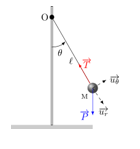PW5 : THE SIMPLE PENDULUM
I. GOALS :
- Highlight the movement of an elementary mechanical system: the simple pendulum.
- Study the influence of different parameters such as length and mass on the proper period of a simple pendulum.
- Visualize the oscillatory motion and calculate experimentally the value of the earth's acceleration.
II. IMPORTANT :
- The protractor must be properly fixed to the horizontal rod to minimize errors on the angle.
- The ruler must be fixed to a nut and using the brackets located on the ruler, the length of the wire can be measured without too much difficulty.
- Reading on graduated devices such as the ruler or the protractor must be done perpendicular to the device.
- It must be ensured that the movement of the simple pendulum is indeed a swinging movement in a plane. There shouldn't be swings in all directions.
III. USED MATERIEL :
- An adjustable foot on which a rod is fixed horizontally.
- Two balls, considered dimensionless, of masses m1 and m2 ( m1 ≠ m2).
- A graduated ruler of length l=1m .
- An inextensible wire.
IV.THEORY :
The simple pendulum is made by suspending a ball of mass from an inextensible wire of length , attached to a bracket by its upper end. The ball is moved slightly away from its equilibrium position (amplitude less than 10°) then released.
According to the figure opposite and by applying the fundamental principle of dynamics,
we obtain :
![]()
T, P, and m represent respectively the tension of the wire, the weight of the mass suspended on the wire and the acceleration of the pendulum.
By projecting onto the tangential axis oriented towards the unitary vector ur, we find the equation of motion :

θ.., l and g represent respectively the
angular acceleration of the pendulum, the length of the wire and the
acceleration of earth's gravity. Knowing that for low amplitudes, we
have sin θ ≈ θ, thus
we obtain : which can be written in the form : with ω = g/l and like T= 2π/ω then we get the simple period formula : In this part, we try to
verify the influence of the length
of the wire on the period
of the movement. We start by
suspending the ball
at the gallows, then, the
length of the wire is varied. For each of
the lengths considered, the ball is slightly moved away from its equilibrium
position
then it
is released without initial speed. Then, we measure the period
of the movement of the pendulum using the
stopwatch. Finally, we draw l = f(t2)
on a millimeter paper. In this part, we want to
verify the influence of the mass of the ball on the period
of the movement. We replace the first mass
ball
by a second mass ball
. We do the same measurements as for the first
part then we draw the graph l = f(t2)
on a millimeter paper.![]()
![]()


V. EXPERIMENTAL PROCEDURE:
V-1. Influence
of the length
of the wire on the period
V-2. Influence of the mass
of the pendulum on the period
